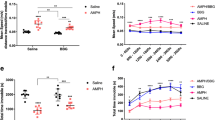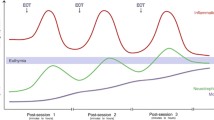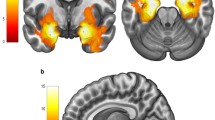Abstract
It is proposed that ATP is released from both neurons and glia during electroconvulsive therapy (ECT) and that this leads to reduction of depressive behaviour via complex stimulation of neurons and glia directly via P2X and P2Y receptors and also via P1 receptors after extracellular breakdown of ATP to adenosine. In particular, A1 adenosine receptors inhibit release of excitatory transmitters, and A2A and P2Y receptors may modulate the release of dopamine. Sequential ECT may lead to changes in purinoceptor expression in mesolimbic and mesocortical regions of the brain implicated in depression and other mood disorders. In particular, increased expression of P2X7 receptors on glial cells would lead to increased release of cytokines, chemokines and neurotrophins. In summary, we suggest that ATP release following ECT involves neurons, glial cells and neuron–glial interactions acting via both P2 and after breakdown to adenosine via P1 receptors. We suggest that ecto-nucleotidase inhibitors (increasing available amounts of ATP) and purinoceptor agonists may enhance the anti-depressive effect of ECT.

Similar content being viewed by others
References
Mackinon AL (1948) Electric shock therapy. Can Med Assoc J 58:478–483
Busnello JV, Oses JP, da Silva RS, Feier G, Barichello T, Quevedo J, Böhmer AE, Kapczinski F, Souza DO, Sarkis JJ, Portela LV (2008) Peripheral nucleotide hydrolysis in rats submitted to a model of electroconvulsive therapy. Prog Neuropsychopharmacol Biol Psychiatry 32:1829–1833
Zervas IM, Theleritis C, Soldatos CR (2011) Using ECT in schizophrenia: a review from a clinical perspective. World J Biol Psychiatry. doi:10.3109/15622975.2011.564653
Soleimani L, Lapidus KA, Iosifescu DV (2011) Diagnosis and treatment of major depressive disorder. Neurol Clin 29:177–193, ix
Mann JJ, Currier DM (2010) Stress, genetics and epigenetic effects on the neurobiology of suicidal behavior and depression. Eur Psychiatry 25:268–271
Bolwig TG (2011) How does electroconvulsive therapy work? Theories on its mechanism. Can J Psychiatry 56:13–18
Taylor SM (2008) Electroconvulsive therapy, brain-derived neurotrophic factor, and possible neurorestorative benefit of the clinical application of electroconvulsive therapy. J ECT 24:160–165
Yatham LN, Liddle PF, Lam RW, Zis AP, Stoessl AJ, Sossi V, Adam MJ, Ruth TJ (2010) Effect of electroconvulsive therapy on brain 5-HT2 receptors in major depression. Br J Psychiatry 196:474–479
Nikisch G, Mathe AA (2008) CSF monoamine metabolites and neuropeptides in depressed patients before and after electroconvulsive therapy. Eur Psychiatry 23:356–359
Burnstock G (2008) Purinergic signalling and disorders of the central nervous system. Nat Rev Drug Discov 7:575–590
Burnstock G (2007) Physiology and pathophysiology of purinergic neurotransmission. Physiol Rev 87:659–797
Burnstock G (1972) Purinergic nerves. Pharmacol Rev 24:509–581
Zimmerman H (2006) Nucleotide signalling in nervous system development. Pflugers Arch 453:573–588
Abbracchio MP, Burnstock G, Verkhratsky A, Zimmermann H (2009) Purinergic signalling in the nervous system: an overview. Trends Neurosci 32:19–29
Dare E, Schulte G, Karovic O, Hammarberg C, Fredholm BB (2007) Modulation of glial cell functions by adenosine receptors. Physiol Behav 92:15–20
Halassa MM, Fellin T, Haydon PG (2009) Tripartite synapses: roles for astrocytic purines in the control of synaptic physiology and behavior. Neuropharmacology 57:343–346
Bowser DN, Khakh BS (2007) Vesicular ATP is the predominant cause of intercellular calcium waves in astrocytes. J Gen Physiol 129:485–491
Gordon GR, Baimoukhametova DV, Hewitt SA, Rajapaksha WR, Fisher TE, Bains JS (2005) Norepinephrine triggers release of glial ATP to increase postsynaptic efficacy. Nat Neurosci 8:1078–1086
Verkhratsky A, Krishtal OA, Burnstock G (2009) Purinoceptors in neuroglia. Mol Neurobiol 39:190–208
Kittner H, Krügel U, Illes P (2001) The purinergic P2 receptor antagonist pyridoxalphosphate-6-azophenyl-2′4′-disulphonic acid prevents both the acute locomotor effects of amphetamine and the behavioural sensitization caused by repeated amphetamine injections in rats. Neuroscience 102:241–243
Kittner H, Krugel U, Hoffmann E, Illes P (2000) Effects of intra-accumbens injection of 2-methylthio ATP: a combined open field and electroencephalographic study in rats. Psychopharmacology (Berl) 150:123–131
Kittner H, Franke H, Fischer W, Schultheis N, Krügel U, Illes P (2003) Stimulation of P2Y1 receptors causes anxiolytic-like effects in the rat elevated plus-maze: implications for the involvement of P2Y1 receptor-mediated nitric oxide production. Neuropsychopharmacology 28:435–444
Dhir A, Kulkarni SK (2011) Nitric oxide and major depression. Nitric Oxide 24:125–131
Taayedi R, Köhler C, Drendel V, Seidel B, Illes P, Krügel U (2007) Purinergic mechanisms mediate depression-like responses to chronic stress. J Neurochem 102:288
Krügel U, Spies O, Regenthal R, Illes P, Kittner H (2004) P2 receptors are involved in the mediation of motivation-related behavior. Purinergic Signal 1:21–29
Basso AM, Bratcher NA, Harris RR, Jarvis MF, Decker MW, Rueter LE (2009) Behavioral profile of P2X7 receptor knockout mice in animal models of depression and anxiety: relevance for neuropsychiatric disorders. Behav Brain Res 198:83–90
Lucae S, Salyakina D, Barden N, Harvey M, Gagne B, Labbe M, Binder EB, Uhr M, Paez-Pereda M, Sillaber I, Ising M, Bruckl T, Lieb R, Holsboer F, Muller-Myhsok B (2006) P2RX7, a gene coding for a purinergic ligand-gated ion channel, is associated with major depressive disorder. Hum Mol Genet 15:2438–2445
Barden N, Harvey M, Gagne B, Shink E, Tremblay M, Raymond C, Labbe M, Villeneuve A, Rochette D, Bordeleau L, Stadler H, Holsboer F, Muller-Myhsok B (2006) Analysis of single nucleotide polymorphisms in genes in the chromosome 12Q24.31 region points to P2RX7 as a susceptibility gene to bipolar affective disorder. Am J Med Genet B Neuropsychiatr Genet 141B:374–382
Franke H, Gunther A, Grosche J, Schmidt R, Rossner S, Reinhardt R, Faber-Zuschratter H, Schneider D, Illes P (2004) P2X7 receptor expression after ischemia in the cerebral cortex of rats. J Neuropathol Exp Neurol 63:686–699
Melani A, Amadio S, Gianfriddo M, Vannucchi MG, Volonté C, Bernardi G, Pedata F, Sancesario G (2006) P2X7 receptor modulation on microglial cells and reduction of brain infarct caused by middle cerebral artery occlusion in rat. J Cereb Blood Flow Metab 26:974–982
Chessell IP, Hatcher JP, Bountra C, Michel AD, Hughes JP, Green P, Egerton J, Murfin M, Richardson J, Peck WL, Grahames CB, Casula MA, Yiangou Y, Birch R, Anand P, Buell GN (2005) Disruption of the P2X7 purinoceptor gene abolishes chronic inflammatory and neuropathic pain. Pain 114:386–396
Hashioka S (2011) Anti-neuroinflammatory effects of psychopharmaceuticals: further than monoamine modulators. Mini Rev Med Chem, in press
Di Virgilio F (2007) Liaisons dangereuses: P2X7 and the inflammasome. Trends Pharmacol Sci 28:465–472
Machado-Vieira R, Lara DR, Souza DO, Kapczinski F (2002) Purinergic dysfunction in mania: an integrative model. Med Hypotheses 58:297–304
Lam P, Hong CJ, Tsai SJ (2005) Association study of A2a adenosine receptor genetic polymorphism in panic disorder. Neurosci Lett 378:98–101
Ferre S, Fredholm BB, Morelli M, Popoli P, Fuxe K (1997) Adenosine-dopamine receptor-receptor interactions as an integrative mechanism in the basal ganglia. Trends Neurosci 20:482–487
Short JL, Ledent C, Drago J, Lawrence AJ (2006) Receptor crosstalk: characterization of mice deficient in dopamine D1 and adenosine A2A receptors. Neuropsychopharmacology 31:525–534
Chen JF, Beilstein M, Xu YH, Turner TJ, Moratalla R, Standaert DG, Aloyo VJ, Fink JS, Schwarzschild MA (2000) Selective attenuation of psychostimulant-induced behavioral responses in mice lacking A2A adenosine receptors. Neuroscience 97:195–204
Johansson B, Halldner L, Dunwiddie TV, Masino SA, Poelchen W, Gimenez-Llort L, Escorihuela RM, Fernandez-Teruel A, Wiesenfeld-Hallin Z, Xu XJ, Hardemark A, Betsholtz C, Herlenius E, Fredholm BB (2001) Hyperalgesia, anxiety, and decreased hypoxic neuroprotection in mice lacking the adenosine A1 receptor. Proc Natl Acad Sci USA 98:9407–9412
Corodimas KP, Tomita H (2001) Adenosine A1 receptor activation selectively impairs the acquisition of contextual fear conditioning in rats. Behav Neurosci 115:1283–1290
Kaster MP, Rosa AO, Rosso MM, Goulart EC, Santos AR, Rodrigues AL (2004) Adenosine administration produces an antidepressant-like effect in mice: evidence for the involvement of A1 and A2A receptors. Neurosci Lett 355:21–22
Nehlig A (2010) Is caffeine a cognitive enhancer? J Alzheimers Dis 20(Suppl 1):S85–S94
El Yacoubi M, Ledent C, Parmentier M, Bertorelli R, Ongini E, Costentin J, Vaugeois JM (2001) Adenosine A2A receptor antagonists are potential antidepressants: evidence based on pharmacology and A2A receptor knockout mice. Br J Pharmacol 134:68–77
Elgun S, Keskinege A, Kumbasar H (1999) Dipeptidyl peptidase IV and adenosine deaminase activity. Decrease in depression. Psychoneuroendocrinology 24:823–832
Burnstock G, Verkhratsky A, Fredholm B (2011) Adenosine and ATP receptors in the brain. Curr Top Med Chem 11:973–1011
Lewin E, Bleck V (1981) Electroshock seizures in mice: effect on brain adenosine and its metabolites. Epilepsia 22:577–581
Guzman SJ, Schmidt H, Franke H, Krügel U, Eilers J, Illes P, Gerevich Z (2010) P2Y1 receptors inhibit long-term depression in the prefrontal cortex. Neuropharmacology 59:406–415
Wieraszko A, Goldsmith G, Seyfried TN (1989) Stimulation-dependent release of adenosine triphosphate from hippocampal slices. Brain Res 485:244–250
Dale N, Frenguelli BG (2009) Release of adenosine and ATP during ischemia and epilepsy. Curr Neuropharmacol 7:160–179
Stout CE, Costantin JL, Naus CC, Charles AC (2002) Intercellular calcium signalling in astrocytes via ATP release through connexin hemichannels. J Biol Chem 277:10482–10488
Iglesias R, Dahl G, Qiu F, Spray DC, Scemes E (2009) Pannexin 1: the molecular substrate of astrocyte “hemichannels”. J Neurosci 29:7092–7097
Kreft M, Potokar M, Stenovec M, Pangrsic T, Zorec R (2009) Regulated exocytosis and vesicle trafficking in astrocytes. Ann N Y Acad Sci 1152:30–42
Burnstock G (1999) Release of vasoactive substances from endothelial cells by shear stress and purinergic mechanosensory transduction. J Anat 194:335–342
Krügel U, Kittner H, Franke H, Illes P (2003) Purinergic modulation of neuronal activity in the mesolimbic dopaminergic system in vivo. Synapse 47:134–142
Fischer W, Krügel U (2007) P2Y receptors: focus on structural, pharmacological and functional aspects in the brain. Curr Med Chem 14:2429–2455
van Calker D, Biber K (2005) The role of glial adenosine receptors in neural resilience and the neurobiology of mood disorders. Neurochem Res 30:1205–1217
de Mendonça A, Sebastião AM, Ribeiro JA (2000) Adenosine: does it have a neuroprotective role after all? Brain Res Brain Res Rev 33:258–274
Skolnick P, Layer RT, Popik P, Nowak G, Paul IA, Trullas R (1996) Adaptation of N-methyl-D-aspartate (NMDA) receptors following antidepressant treatment: implications for the pharmacotherapy of depression. Pharmacopsychiatry 29:23–26
Ferrari D, Pizzirani C, Adinolfi E, Lemoli RM, Curti A, Idzko M, Panther E, Di Virgilio F (2006) The P2X7 receptor: a key player in IL-1 processing and release. J Immunol 176:3877–3883
Sperlágh B, Vizi ES, Wirkner K, Illes P (2006) P2X7 receptors in the nervous system. Prog Neurobiol 78:327–346
Suadicani SO, Brosnan CF, Scemes E (2006) P2X7 receptors mediate ATP release and amplification of astrocytic intercellular Ca2+ signalling. J Neurosci 26:1378–1385
Cunha RA, Vizi ES, Ribeiro JA, Sebastiao AM (1996) Preferential release of ATP and its extracellular catabolism as a source of adenosine upon high- but not low-frequency stimulation of rat hippocampal slices. J Neurochem 67:2180–2187
Wieraszko A (1996) Extracellular ATP as a neurotransmitter: its role in synaptic plasticity in the hippocampus. Acta Neurobiol Exp (Warsz) 56:637–648
Randall PA, Nunes EJ, Janniere SL, Stopper CM, Farrar AM, Sager TN, Baqi Y, Hockemeyer J, Müller CE, Salamone JD (2011) Stimulant effects of adenosine antagonists on operant behavior: differential actions of selective A2A and A1 antagonists. Psychopharmacology (Berl). doi:10.1007/s00213-011-2198-3
Baqi Y, Hausmann R, Rosefort C, Rettinger J, Schmalzing G, Muller CE (2011) Discovery of potent competitive antagonists and positive modulators of the P2X2 receptor. J Med Chem 54(3):817–830
Conflict of interest
The authors have no competing interests that might be perceived to influence the results and discussion reported in this paper.
Author information
Authors and Affiliations
Corresponding author
Rights and permissions
About this article
Cite this article
Sadek, AR., Knight, G.E. & Burnstock, G. Electroconvulsive therapy: a novel hypothesis for the involvement of purinergic signalling. Purinergic Signalling 7, 447–452 (2011). https://doi.org/10.1007/s11302-011-9242-y
Received:
Accepted:
Published:
Issue Date:
DOI: https://doi.org/10.1007/s11302-011-9242-y




